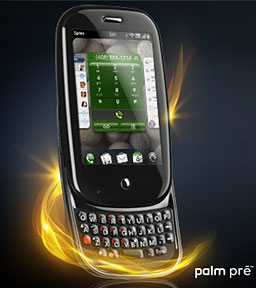Like the characters in the wonderful novels by
Gabriel Garcia Marquez, Palm's Roger McNamee lives in a fantasy
world. From a March 5th
interview: "You know the beautiful thing: June 29, 2009, is the
two-year anniversary of the first shipment of the iPhone, not one of
those people will still be using an iPhone a month later."
Running Out of Cash
Palm is running out of cash. In the last quarter, Palm has run
through nearly $100 million, following a smaller loss the previous
quarter. According to the
8-K filed with the SEC on March 3 giving preliminary results for
the quarter ending Feb 27, it only has left $215 to $220 million in
cash and cash equivalents.

Palm expects to launch the Prē before the end of June, which
suggests another $100 million to cover day-to-day operations even if
the Treo and Centro keep selling at current rates. However, it "expects
declining revenues and continued margin pressure from its legacy
product lines in the fiscal fourth quarter", so it's cash needs could
be significantly greater.
Palm then has to cover the Prē launch costs.
Raising New Funds
Palm believes it has enough cash on hand, but the 8-K also says that
it is looking to raise money. The problem is how. The shares are over
$6 and, provided they can be sold over $3.25, Palm can sell part of
the shares due to Elevation Partners and keep the profit. At $6,
this would raise at most $50 million - 6-7 weeks cash at current burn
rates. Under today's (March 10) filing, Palm is looking to sell enough
shares to raise $83.9 million (or $103.6 million if the underwriters
take up their option).
But in this market, who will buy new shares in a company whose days
look to be numbered?
If this share issue fails, where will Palm go to raise money? Even
in good times, issuing bonds would be difficult and expensive when
Standard & Poor rate Palm as
8 levels below investment grade, with further downgrades
likely.
Palm's major shareholder, Elevation Partners, a venture capital
organisation, already holds 39% of the shares and is probably brushing
against the limits of investment mandates, which typically restrict how
much of the fund can be put into a single company. So new money from
Elevation looks unlikely.
Selling the patent portfolio is always possible, but with a
desperate seller, in times like these, will that even go for $50
million? In 2002, SGI sold it's extensive core graphics patents to
Microsoft for just $62.5 million.
Sprint is hoping the launch of the Prē will reverse or at least
stop its loss of customers while the carrier has an exclusive. However,
since Sprint has lost a total of $650 million over the last six
quarters, money is unlikely to come from that direction unless the
Prē is a proven winner.
Costly Production
Even if Palm staggers to the start line with the Prē, it faces
real issues with component pricing and availability and cash flow
during the ramp up of production. For suppliers, this is not like
dealing with Apple, where they know there is $28 billion available, so
they will be paid no matter what.
As Palm can not commit to and pay for a long production run, all
Prē custom components will be priced on more expensive short runs,
and suppliers are likely to insist on immediate payment or prepayment,
as will the contract manufacturer for the handset. If the Prē
doesn't sell out immediately, suppliers may commit the production
capacity to another customer, leaving Palm unable to fulfill an order
quickly. With a commodity component like NAND memory, where Apple can
lock in low prices for all likely future needs, Palm will have to pay
close to the market price.
An 8 GB Prē will be more expensive to produce than an 8 GB
iPhone. If AT&T drops the starter iPhone price to $99 or $0 +
contract, and with the development of the iPhone/iPod touch range
discussed in the previous two articles (ARM Netbooks Could Make OS X the Mobile
OS to Rule Them All and High Def iPhone and iPod touch Could
Make OS X the Mobile OS to Rule them All), will Palm be able to
match pricing and still make a profit?
Competition for Developers
How will Palm attract enough developers?
The iPhone, RIM, and Nokia all have strongly established user bases
with online stores available now, and open source developers will stay
with Android. For many people looking at buying smartphones, the phone
is as much about what other useful software is available as how good
the handset is.
The Palm Prē and WebOS may well be better than the iPhone in
certain ways, but without good third party software to exploit those
advantages, the Prē is another feature phone trying to sell at a
smartphone price.
It looks like the only hope is to gain some early traction with the
Prē and then sell Palm to another company that needs an up-to-date
mobile OS now. If Apple doesn't launch a patent action in the courts,
the obvious possibilities include Microsoft or Sony-Ericsson to use
WebOS as a much better replacement for Windows Mobile (and possibly
it's Symbian line) and to open up the US market - or perhaps a
manufacturer such as HTC, which has made over 80% of the Windows Mobile
cellphones.
Given Palm's situation, acquiring it shouldn't cost too much.




